[press release]
Apollo 11 stamps celebrate first moon landing – and the significant Canadian contributions to the mission
Canadians played pivotal roles in landing humans on the moon
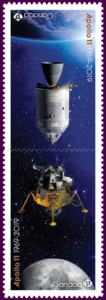 LONGUEUIL, QUE. – Canada Post today issued two commemorative stamps celebrating the 50th anniversary of the historic Apollo 11 mission that landed humans on the moon for the first time – and the Canadians who helped make it possible.
LONGUEUIL, QUE. – Canada Post today issued two commemorative stamps celebrating the 50th anniversary of the historic Apollo 11 mission that landed humans on the moon for the first time – and the Canadians who helped make it possible.
On July 20, 1969, more than half a billion people around the world were transfixed by grainy black and white television footage of astronaut Neil Armstrong taking humankind’s first steps on the moon. The mission was a giant leap for human space exploration and featured significant Canadian ingenuity and innovation. Canadian engineers working at NASA, and a company based in Longueuil, Quebec, that built part of the lunar lander, were instrumental in making the mission a success:
James (Jim) Chamberlin
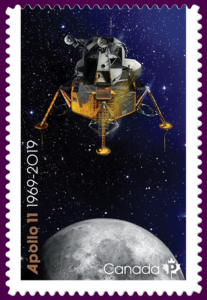 Jim Chamberlin was a leading figure in aircraft design in Canada before moving to the U.S. in 1959 to work for NASA. He became head of engineering for Project Mercury, the first human spaceflight program for the United States, and project manager and chief designer for the Gemini spacecraft that preceded Apollo. He helped determine the type of spacecraft that would transport the Apollo 11 astronauts and was one of the first at NASA to recognize that flying directly to the moon wasn’t the best option. Instead, Chamberlin favoured having a smaller landing module travel to lunar orbit attached to the main spacecraft, then descend to the moon’s surface and later reconnect with the main spacecraft. This approach, known as lunar orbit rendezvous, became fundamental to the Apollo program.
Jim Chamberlin was a leading figure in aircraft design in Canada before moving to the U.S. in 1959 to work for NASA. He became head of engineering for Project Mercury, the first human spaceflight program for the United States, and project manager and chief designer for the Gemini spacecraft that preceded Apollo. He helped determine the type of spacecraft that would transport the Apollo 11 astronauts and was one of the first at NASA to recognize that flying directly to the moon wasn’t the best option. Instead, Chamberlin favoured having a smaller landing module travel to lunar orbit attached to the main spacecraft, then descend to the moon’s surface and later reconnect with the main spacecraft. This approach, known as lunar orbit rendezvous, became fundamental to the Apollo program.
Owen Maynard
One of Ca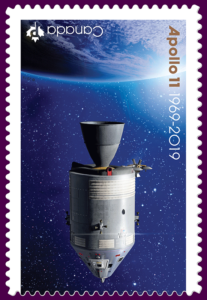 nada’s top aircraft engineers before being hired by NASA in 1959, Owen Maynard went on to head the Systems Engineering Division for the Apollo spacecraft program – effectively making him the chief engineer. He sketched early designs of the main Apollo command module and is credited as the person at NASA most responsible for the design of the lunar lander. He also served as Chief of the Mission Operations Division and was responsible for planning the sequence of missions that led to Apollo 11. Like Chamberlin, Maynard also played an important role in determining the safest way to reach and land on the moon.
nada’s top aircraft engineers before being hired by NASA in 1959, Owen Maynard went on to head the Systems Engineering Division for the Apollo spacecraft program – effectively making him the chief engineer. He sketched early designs of the main Apollo command module and is credited as the person at NASA most responsible for the design of the lunar lander. He also served as Chief of the Mission Operations Division and was responsible for planning the sequence of missions that led to Apollo 11. Like Chamberlin, Maynard also played an important role in determining the safest way to reach and land on the moon.
Héroux-Devtek
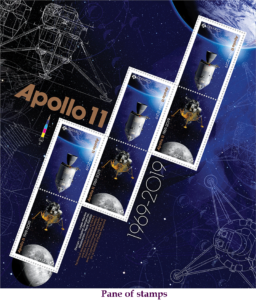 The first legs to stand on the moon didn’t belong to Neil Armstrong – they were from Héroux Machine Parts Limited of Longueuil, Quebec. Now known as Héroux-Devtek, the company manufactured the spider-like landing gear legs on the lunar module to NASA’s specifications. The legs were also part of the launch platform that let Neil Armstrong and Buzz Aldrin lift off from the moon and reconnect with the main command module. Those legs remain on the moon at the Apollo 11 landing site, in an area known as the Sea of Tranquility.
The first legs to stand on the moon didn’t belong to Neil Armstrong – they were from Héroux Machine Parts Limited of Longueuil, Quebec. Now known as Héroux-Devtek, the company manufactured the spider-like landing gear legs on the lunar module to NASA’s specifications. The legs were also part of the launch platform that let Neil Armstrong and Buzz Aldrin lift off from the moon and reconnect with the main command module. Those legs remain on the moon at the Apollo 11 landing site, in an area known as the Sea of Tranquility.
The stamp issue, designed by Matthew Clark of Subplot Design Inc. and illustrated by Mack Sztaba, was printed by Lowe-Martin and is available in a booklet of 10 stamps and a pane of six. The Official First Day Cover is cancelled in Longueuil, home of Héroux-Devtek.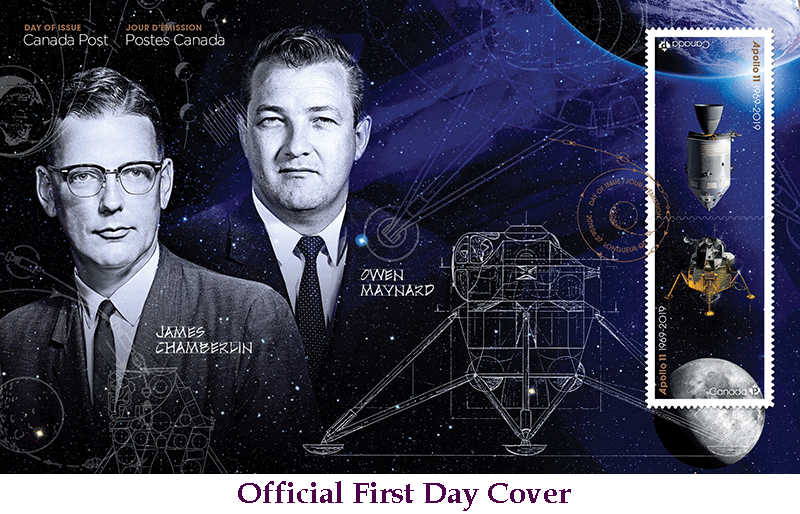
The stamps and related collectibles are available at canadapost.ca/shop and at postal outlets across Canada.  [en Francais]
[en Francais]
Les timbres sur la mission Apollo 11 rendent hommage aux premiers pas de l’humanité sur la Lune et à l’apport important des Canadiens
Le Canada a joué un rôle de pivot dans l’atterrissage sur la Lune
 LONGUEUIL, QUÉBEC – Aujourd’hui, Postes Canada a émis deux timbres-poste commémoratifs en l’honneur du 50e anniversaire de la mission Apollo 11 et des Canadiens qui ont contribué au succès du moment historique où l’humanité a fait ses premiers pas sur la Lune.
LONGUEUIL, QUÉBEC – Aujourd’hui, Postes Canada a émis deux timbres-poste commémoratifs en l’honneur du 50e anniversaire de la mission Apollo 11 et des Canadiens qui ont contribué au succès du moment historique où l’humanité a fait ses premiers pas sur la Lune.
Le 20 juillet 1969, plus d’un demi-milliard de personnes ont les yeux rivés sur leur télé où apparaissent les images floues en noir et blanc de l’astronaute Neil Armstrong qui devient le premier humain à marcher sur la Lune. Grâce à la mission Apollo 11 et à l’ingéniosité et à l’innovation canadiennes, l’humanité fait alors un pas de géant dans l’exploration spatiale. Des ingénieurs canadiens de la NASA de même que l’entreprise de Longueuil chargée de construire une partie du module lunaire ont joué un rôle important dans le succès de cette mission.
James (Jim) Chamberlin
Jim Chamberlin a joué un rôle prépondérant dans la conception d’aéronefs au Canada avant de s’établir aux États-Unis en 1959 pour travailler à la NASA. Il est devenu ingénieur en chef du projet Mercury, le premier programme américain visant à envoyer un humain dans l’espace, et directeur de projet et concepteur en chef de la navette Gemini qui a précédé l’Apollo. Il a aidé la NASA à choisir le vaisseau spatial qui transporterait les astronautes de la mission Apollo 11 et a été un des premiers à reconnaître qu’un vol direct vers la Lune n’était pas la meilleure approche. M. Chamberlain préférait plutôt envoyer dans l’orbite lunaire un module d’exploration plus petit fixé à l’engin principal. Ce module descendrait seul jusqu’à la surface de la Lune et se rattacherait ensuite au vaisseau principal. Cette approche, mieux connue sous le nom de rendez-vous en orbite lunaire, est devenue fondamentale pour le programme Apollo.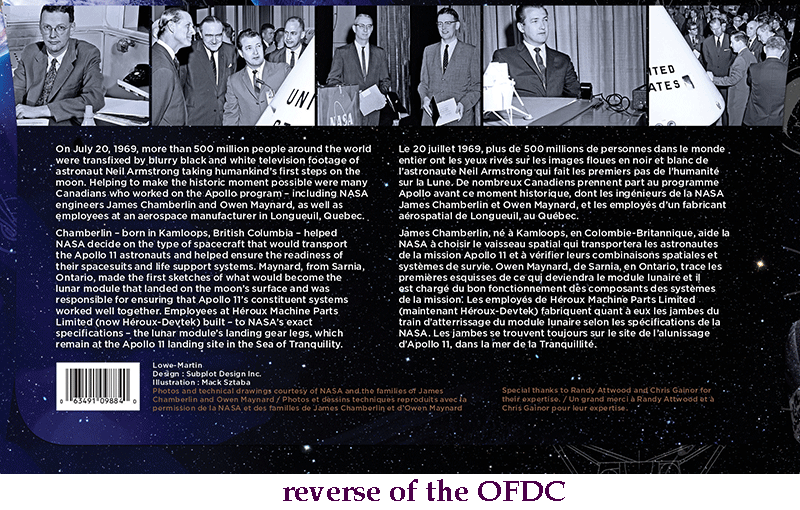
Owen Maynard
Avant son embauche à la NASA en 1959, M. Maynard était l’un des principaux ingénieurs d’aéronefs du Canada. Il a dirigé la Division de l’ingénierie des systèmes pour l’ensemble du programme Apollo, ce qui a fait de lui l’ingénieur en chef. Il a tracé les premières esquisses du module de commande Apollo et est reconnu comme étant le principal responsable à la NASA de la conception du vaisseau lunaire. Il a également été chef de la Division des opérations de mission et était chargé de planifier la séquence des missions qui ont mené à Apollo 11. Tout comme M. Chamberlin, M. Maynard a grandement contribué à déterminer la façon la plus sécuritaire de se rendre et d’atterrir sur la Lune.
Héroux-Devtek
 Les premières jambes à se tenir sur la Lune n’étaient pas celles de Neil Armstrong – elles étaient confectionnées par Héroux Machine Parts de Longueuil, au Québec. Maintenant nommée Héroux-Devtek, l’entreprise a construit les jambes du train d’atterrissage, semblables à des pattes d’araignée, selon les spécifications de la NASA. Elles étaient fixées à la plateforme de lancement qui a permis à Neil Armstrong et à Buzz Aldrin de quitter la Lune pour rejoindre le module de commande principal. Les jambes se trouvent toujours sur le site de l’alunissage d’Apollo 11, dans la mer de la Tranquillité.
Les premières jambes à se tenir sur la Lune n’étaient pas celles de Neil Armstrong – elles étaient confectionnées par Héroux Machine Parts de Longueuil, au Québec. Maintenant nommée Héroux-Devtek, l’entreprise a construit les jambes du train d’atterrissage, semblables à des pattes d’araignée, selon les spécifications de la NASA. Elles étaient fixées à la plateforme de lancement qui a permis à Neil Armstrong et à Buzz Aldrin de quitter la Lune pour rejoindre le module de commande principal. Les jambes se trouvent toujours sur le site de l’alunissage d’Apollo 11, dans la mer de la Tranquillité.
Les timbres, conçus par Matthew Clark de Subplot Design Inc. et illustrés par Mack Sztaba, sont imprimés par Lowe-Martin. Ils sont vendus en carnet de 10 et en feuillet de 6. Le pli Premier Jour officiel est oblitéré à Longueuil, ville où est situé le siège social de Héroux-Devtek.
Les timbres et autres articles de collection sont en vente à postescanada.ca/boutique et dans les comptoirs postaux d’un bout à l’autre du pays.
Updated July 3rd:
Canada Post tells The Virtual Stamp Club that the booklet versions of these stamps are self-adhesive, while the sheet versions are water-activated. Other details from the CPC website:
Issue date: June 27, 2019
Stamp designer: Subplot Design inc.
Stamp value: Permanentt™ (domestic rate)
Booklet version:
Quantity products: 240,000
Dimensions: 30 mm x 45 mm
Product # 414116111
Sheet version:
Quantity products: 40,000
Dimensions: 160 mm x 180 mm
Product # 404116107



